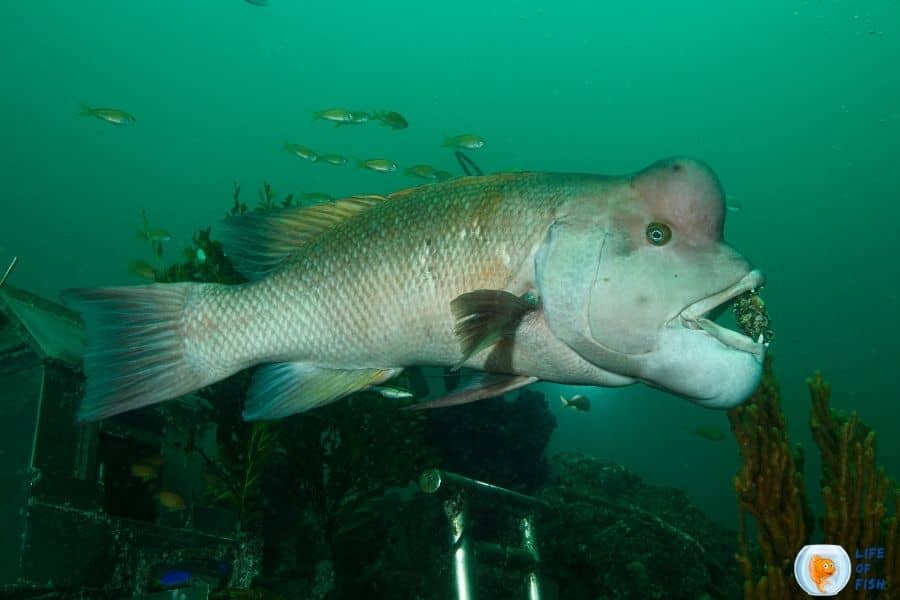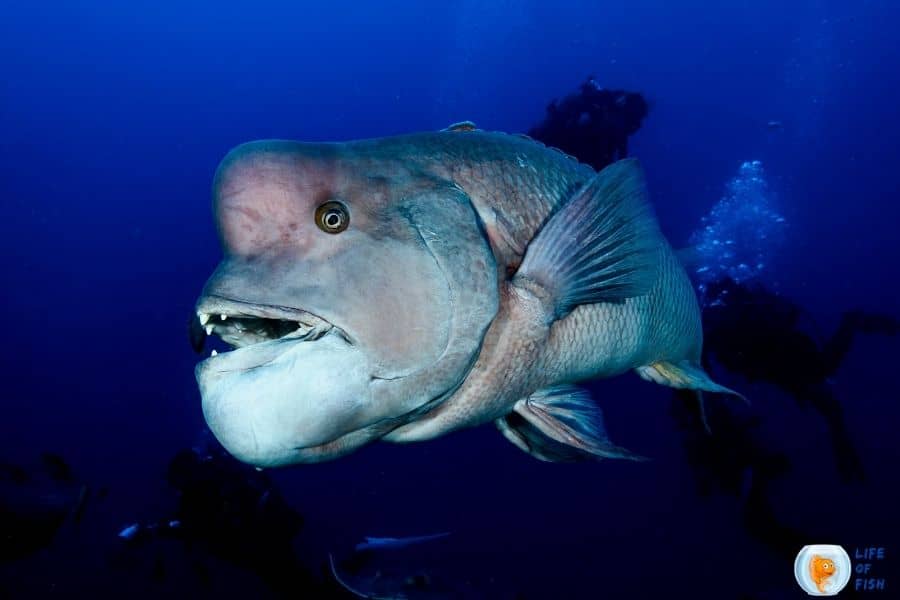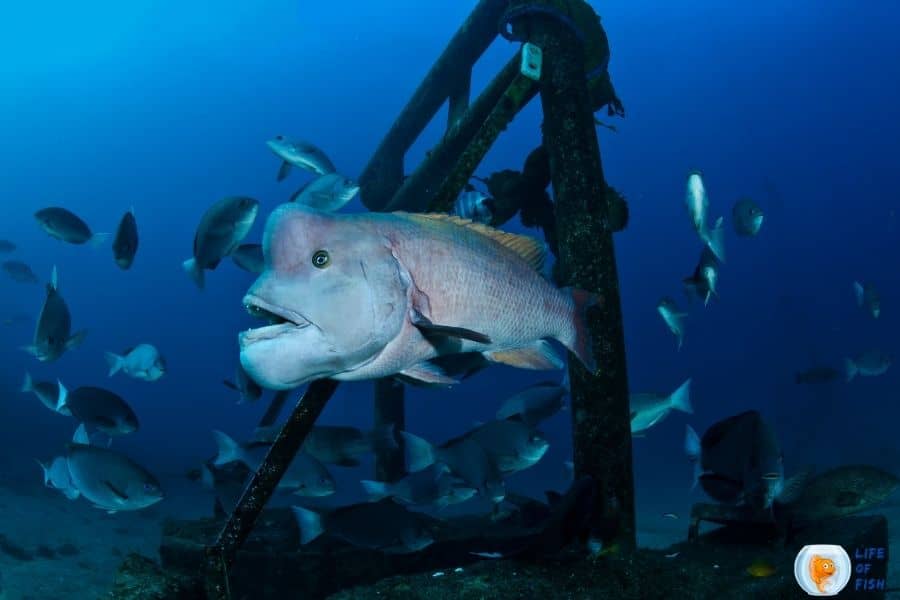The Asian sheepshead wrasse is one of the largest species of wrasses family. They are marine water fish and native to the western Pacific Ocean, especially in Japan, China South Korea, and North Korea.
They are also called Kobudai in Japan. The Asian sheepshead wrasse is not suitable for a home aquarium. The Asian sheepshead wrasse belongs to the Class of Actinopterygii. It belongs to the family Labridae and the genus Semicossyphus with the scientific name Semicossyphus reticulatus. The species is a data deficient species in the IUCN Red List.

How Asian sheepshead wrasse looks like
Jump To
They possess many distinctive features. The most prominent feature of This fish is its large humphead. They also have a distinctive chin and thick lower jaws. These special features give them a unique appearance. Their chin is connected to the large wet scaled face connecting to the forehead. The body is mostly light pink in color ranging to brown as well.
During the breeding season, they tend to adopt a whitish hue near the belly and forehead. Their teeth are also a prominent and visible feature seen in the adult. The Asian sheepshead wrasse has narrow elliptical bodies. They are large wrasses and they can reach the length of 100cm (39in). The maximum recorded weight of this species is 14.7 kg (32lb).
However, young Asian sheepshead wrasses are remarkably different from adults. They are orange in color and they don’t have large humps or chins like their adults. More on, they don’t have sharp teeth and you will not identify young wrasse as they are completely different from the adults.
They have quite a long lifespan. Their lifespan ranges to about 20 years on average. However, in some literature, the maximum age was recorded as 25 years for males and 30 years for females. Interested in learning about the many species of wrasse fish? Our guide has all the information you need!”
Where Asian sheepshead wrasse live
They mainly living within the Asian borders and they live in the water bodies around Asian countries, especially near the coral reefs. The largest wrasse species are dominantly found in Japan across the western Pacific Ocean. They also live in rocky reef areas around the Korean Peninsula (Both South and North Korea ), and the Ogasawara Islands.
This species of wrasse is a fish underwater in a depth of around 8-20m.
The depth range in which they are dwelling may differ depending on various reasons and sometimes they dwell in 5 meters depth too. They spend most of their lives around rocky reef areas and prefer a subtropical environment. They also live in the open seas and along the subtidal aquatic beds of the ocean apart from rocky reefs. As they are subtropical fish they prefer water temperatures around 78.8 °F (26°C).
Their behavior
The Asian sheepshead wrasses are mostly solitary species. They swim around the waters of coral reefs and prey on marine species independently. Asian sheepshead wrasses change their solitary behavior only during the breeding season. They form pairs of male and female for the sole purpose of spawning and after the spawning, they again live alone.
During the spawning time, the individuals of this species find in pairs or in groups of pairs. They are very friendly creatures to humans and one of the Japanese divers has been friends with an Asian sheepshead wrasse named Yorico for 25 years!!

What does Asian sheepshead wrasse eat?
They consume both plant and animal matter, hence consider as omnivores. The main food types of them are Shellfish, blue crab, oysters, clams, crustaceans, and small fish. Apart from this they also feed on zooplankton, polychaetes, and chironomid (midges) larvae.
Asian sheepshead wrasse breeding
Like many wrasses, the Japanese-based species of Asian sheepshead wrasse shows sequential hermaphrodite by nature. The sequential hermaphrodite means changing the gender of the prominent or the largest female into a male in case of lack of a dominant male. All the wrasses of this species are born as a female and then based on the situation they change their gender into males.
Because they can change their gender during their breeding season and their breeding patterns are quite unique and interesting. In a situation of death or loss of the dominant male of a group, the largest female undergoes a physical change and becomes a male.
The main purpose of this behavior is to mate. They become sexually mature at age of two and that is a quite short time when comparing the maturity period of other species of the wrasse family.
When they pair together for spawning they become highly territorial. After attaining sexual maturity the mature male and female look for a suitable environment for the gestation period. They are mostly rome along the coral reefs during the gestation period. The fertilized eggs of these reef fish are found along the waters of coral reefs.
However, breeding behaviors of this species are still hidden and the only observation of mating behavior in an Asian sheepshead wrasse occurred in an aquarium. The largest male of the wrasse group chased away all the other males if available and then proceed to mate with the female at the surface.
The release of the sperms and the eggs happen at the same time. The eggs get fertilized with the help of water currents.
The resulting fry spends around two years to become mature. The juveniles are different from the adults due to the absence of distinguishable features such as the hump and chin. Being in the family of wrasse the breeding rate of this species is quite low.
Importance of Asian sheepshead wrasse
They are a delicious meal for larger shark species. The biggest predator of this species is humans. The fish has a higher value of consumption by humans due to its mild flesh and flavor.
Do people eat Asian sheepshead wrasse?
Yes, The Asian sheepshead wrasse is famous for its mild flesh among the regions of China, Japan, and Korea.
Conservation status
The biggest challenge in protecting these fish is the deficiency of data on their feed, breeding, and life cycle. They are under the data deficiency category of the IUCN. The exact number of living fish of this species is not known but frequent divers and scientists report a decreasing trend in their population. One of the major reasons for the decreasing of their population is the low reproduction rate of this species. More on, they take quite a long time to grow.

Related Question
What kind of fish is an Asian sheepshead wrasse?
They are the largest labrid in temperate waters around Japan. They live mainly in Japan, China, North Korea, and South Korea. Few distinguishing features and the resultant of those features does not give a pleasant appearance. Due to the prominent set of teeth, they look scary!
Are Asian sheepshead wrasses rare?
They are not rare actually. The number of living fish of this species is not known exactly. However, frequent divers and scientists report a decreasing trend in their population.
Are Asian sheepshead wrasses poisonous?
No. Their flesh consider delicious food
Conclusion
The Asian sheepshead wrasse is a large fish living on the Asian border of the Pacific Ocean. They don’t have a pleasant appearance due to some distinguishable features such as a big hump, chin, and large teeth and therefore do not suitable for a home aquarium.
However, many of the details of this species are still not known such as their growth, reproduction, and preferred environmental conditions.
Read Next : Orange Back Fairy Wrasse Care ( A Fairy In The Fish World ) Humphead Wrasse | The Amazing Gender-Shifting Fish
